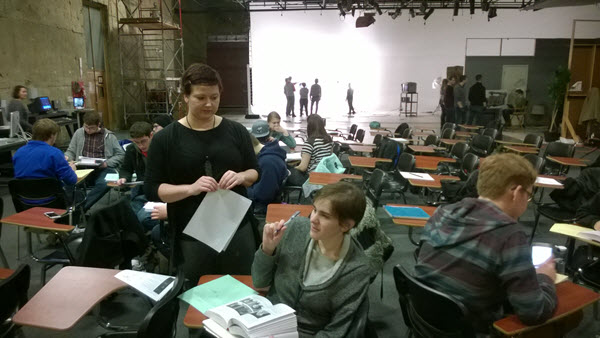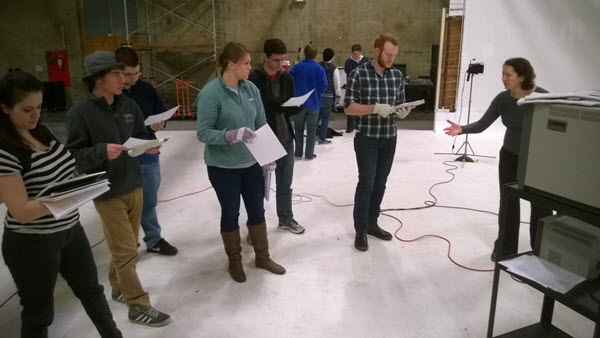By Doug Ward
Students aren’t always sure what to make of a flipped class. Some resist and complain. Others take to the format immediately and recognize how it helps them learn. Most are somewhere in between.
A class in film and media studies that Anne Gilbert helped transform provides a good example of student reaction.
“The students who are in the class, they’re learning a lot,” she said. “They’re a little bit overwhelmed in the beginning. They sort of have this look on their face: ‘There’s so much going on. I love all of this, but I’m so scared.’ ”

The class she describes is Basic Video Production, or Film and Media Studies 275. Gilbert, who was a post-doctoral teaching fellow at KU and is now an assistant professor at the University of Georgia, worked with Meg Jamieson, the instructor of the class, to transform it into an active learning format. Rather than lecturing to students about concepts and then having students explore those concepts in lab, they shifted much of the material to a hands-on format in the classroom.
“The hope is that the connection between studies and practice, which is at the heart of film and media studies as a degree, can be implemented a little more deeply with the flipped classroom,” Jamieson said.
The accompanying video explains more about the approach that Jamieson and Gilbert took in remaking the class. They worked with other faculty members in their department to home in on what students needed to take away from FMS 275 to prepare them for subsequent classes. They created videos and other assignments that allowed them to shift some in-class material online. That gave them freedom to experiment with in-class techniques like a series of stations that students rotated through to learn the basics of lighting. That, in turn, freed up lab time so that students could spend more time creating, editing and honing their video productions.
None of this was easy. Gilbert said that she and Jamieson spent 10 to 15 hours a week planning and creating materials in the semester before they taught the class in a flipped format. They created a pre-test so they had a better sense of students’ skill levels when they entered the class. Other faculty members contributed material, as well, and helped with some of the class sessions.
There were glitches along the way, as there are in any course redesign. Some students saw the new format as too much work. And, not surprisingly, the graduate teaching assistants in the class needed help in adapting to the new format. That’s a crucial aspect of any change in a class. Everyone involved has to understand the goals and the methods.

Gilbert spent a considerable amount of time helping the GTAs understand teaching styles “that don’t involve standing in front of the classroom and explaining things.” They were “a little unsettled at their changing position,” she said.
That led to discussions about what teaching involves, and ultimately helped improve the class and helped the teaching assistants improve their work.
“They don’t necessarily understand that when the students do an activity in class and you’re circulating around and helping them – that is teaching,” Gilbert said. “They don’t see that as teaching. They see that as the students doing an activity. They ask how students are learning things because I haven’t taught it to them. It’s like, ‘Well, this is teaching. This is how they are learning.’ ”
Students did indeed learn. Gilbert and Jamieson both said that the quality of student projects had improved with the flipped format. Other instructors have found the same, and the evidence about flipped teaching and other forms of active learning continues to grow.
You can read more about teaching in a flipped format in the CTE portfolio and poster gallery. Instructors in music, economics, engineering, Latin, psychology, and physics have all had good results with flipping their classes. They are good examples of how instructors, not just students, are learning in a flipped format.
Doug Ward is the associate director of the Center for Teaching Excellence and an associate professor of journalism. You can follow him on Twitter @kuediting.